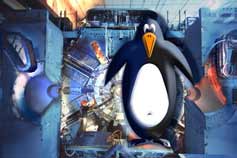

Thursday - September 28, 2006
SLAC Today is
available online at:
http://today.slac.stanford.edu
In this issue:
New Form of CP Violation Discovered
Science Today: A Hunt for Gravitational Mirages
SCCS Seeks Team to Evaluate E-mail Storage
 |
 |
|
Thursday - September 28, 2006 |

The BaBar collaboration has discovered CP violation in rare penguin decays.
New Form of CP Violation DiscoveredFinding something expected has brought researchers at SLAC one step closer to discovering the unexpected. The BaBar collaboration has discovered that CP violation—an asymmetry between the behavior of matter and antimatter—exists even in a very rare class of particle decays. This result offers the most sensitive avenue yet for exploring matter-antimatter asymmetries, with implications for the future understanding of physics beyond the Standard Model. "BaBar has proven to be a fantastic instrument for exploring the origins of matter-antimatter asymmetries, allowing us to probe with exquisite precision very rare processes related to how the early universe came to be matter dominated," said BaBar Spokesperson David MacFarlane. Read more... |
||
|
|
||
 A Hunt for Gravitational Mirages
A recent explosive development in astrophysics research has revealed that 96 percent of the universe is filled by unknown components called dark matter and dark energy. The nature of these dark components is a central problem in modern cosmology. My collaborators and I are tackling the problem by making use of "gravitational mirages." A gravitational mirage, or gravitational lensing, is the drastic bending of light by gravity. It occurs when light from a single distant object is bent by the gravitational pull of a closer object, causing multiple images of the distant object to be visible. Gravitational mirages are thought to be an ideal tool to study the dark components of the universe because they are due solely to gravity. Our group is searching for these cosmic mirages using data from the Sloan Digital Sky Survey (SDSS). The survey uses the dedicated 2.5-meter telescope in New Mexico to map a quarter of the entire sky. From the vast data of the SDSS, gravitational lensing is searched by checking the morphology of distant quasars (bright star-like objects powered by super-massive black holes). After the first discovery in 1979, about 90 mirages of quasars have been discovered to date. Using the SDSS data, our group has discovered about 20 new mirages, accounting for a significant fraction of the total. Since the discoveries have been made by using only the half of SDSS data, we believe that we will find more and more such mirages in the coming years. |
SCCS Seeks Team to Evaluate E-mail StorageThe growth of e-mail stored at SLAC is having a significant impact on how we in Scientific Computing and Computing Services (SCCS) manage the software and hardware behind our e-mail infrastructure. We are approaching one terabyte of e-mail now and growing. As these databases grow, so does the time that is needed to recover from any failure or disaster. The costs and the efforts to keep our e-mail in prime storage devices are becoming prohibitive in both real dollars and in administrative time. We know that your e-mail is important and want to deliver the proper resources that allow you to do your job. In an effort to strike a balance among end-user functionality, management costs and regulatory compliance, we are investigating the possibility of server-side archiving of e-mails. This would mean that seldom used or older e-mails would be automatically archived and moved to secondary, less expensive storage mediums. At the same time we want to choose a product which will allow you to retrieve an archived e-mail in a way which would cause as little delay to you as possible. We invite anyone interested to be a part of the decision process as we evaluate the product offerings and move towards the testing phase. To join this team, please send an e-mail to majordomo@slac.stanford.edu with "subscribe email-archive-user" in the body. We would share with this group the features available on the products we are considering and we will seek your input and asking you to tell us what is most important to you. We would later want to include this same group in the testing phase of the final product or products chosen. |
Events (see all | submit)
Access (see all)
Announcements
|
| | ||
|
|
||
 <%
Response.AddHeader "Last-modified", getArticleDate()
'Response.AddHeader "Last-modified","Mon, 01 Sep 1997 01:03:33 GMT"
'Monday, December 06, 2010
%>
<%
Response.AddHeader "Last-modified", getArticleDate()
'Response.AddHeader "Last-modified","Mon, 01 Sep 1997 01:03:33 GMT"
'Monday, December 06, 2010
%>View online at http://today.slac.stanford.edu/. |
||